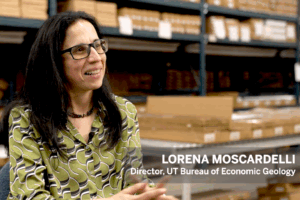Professor Mark Raizen not only advises his students to pay attention to what’s going on in other fields, he shows them how it’s done.
“It’s something I emphasize to my students — that the directions you take in research are often guided by other fields, completely unexpected fields,” he says. “It’s important to keep an open mind and learn about what other people are doing outside your field because that’s where the next important idea’s going to come from.”

In his quest to control atoms to a greater and greater degree, Raizen, a physics professor at The University of Texas at Austin, has borrowed ideas from chemistry, electromechanics and plasma physics.
His journey demonstrates scientific creativity and the parts that serendipity and intuition play in discovery and that ideas can come from unexpected sources and arrive at unlikely times and places.
It started in 2005 when Raizen took up the idea of controlling atoms.
Sure, lasers could be used to control atoms of elements such as the alkalis — sodium, lithium and rubidium, but Raizen thought there must be a way to control other elements.
His first thought was that it would be good to control hydrogen, the simplest and most abundant element in the universe. Get hydrogen under control and you might answer fundamental physics questions.
But then it became a Mount Everest-type challenge, he says, “something that people thought couldn’t be done.”
Before you can control atoms, you have to slow them down.
Starting to slow
Raizen began with the idea of cooling atoms by putting them in a box. But it wasn’t any box. This one was made of laser light.
Then he divided the box into two parts, using more lasers as the divider. The lasers allowed atoms to pass through the wall from one side of the box to the other but blocked them from getting back.
This method extended the capabilities of laser and evaporative cooling to a wider range of atoms in the periodic table.
In the next step, Raizen borrowed a technique used in chemistry, the supersonic beam.
“It’s a method they use to take some material, whether it’s an atom or a molecule, and make a beam in vacuum that would have very unusual properties,” he says.
The beam slowed helium atoms to 560 miles per hour, less than one-eighth the normal velocity.
Looking to slow atoms even more, Raizen searched for a common characteristic among atoms. He struck upon the fact that most atoms have magnetic properties. That was something he could use.
Then serendipity stepped in and presented Raizen with an electromagnetic device.
Arms control
Raizen came in contact with the university’s Center for Electromechanics (CEM). He met with its director, Robert Hebner, and took a tour of the center.
Raizen was interested in rapidly spinning objects, and the CEM is where the university’s experts on rapidly spinning objects are.
Never one to short-change a visitor, Hebner included other projects besides rapidly spinning objects on the tour. One project involved an electromagnetic launch device.
The device, known as a coil gun, “takes bullets and launches them from rest to very high velocities of a thousand meters per second using pulsed magnetic fields,” Raizen says.
The bullets are effective, able to pierce hard metal. That research is done for the Defense Department.
“We were concentrating on the mechanical rotor (the rapidly spinning object) but then we saw the coil gun set up,” Raizen says. “And it didn’t hit me immediately.”

Using the coil gun in his atom experiments struck him, as such ideas usually do, when he was traveling. In May 2006 he was in Japan for a conference. He was jet-lagged and unable to sleep.
“I was thinking at the time of maybe using the coil gun to actually mount a bullet — a real bullet — where we put a silicon wafer on the bullet and use that to make a linear accelerator,” Raizen says. “But then I thought to myself, ‘Get rid of the bullet, get rid of the silicon. Just use the atom itself as the bullet.’ That was the insight at that time.”
Then he did what any self-respecting husband would do. He woke his wife Alicia and told her his idea. “I asked her if she thought it would work, and she said she’s sure it would.”
He brought the idea back to his lab, where he and his students built their own atomic coil gun.
(“I worry sometimes that I drive my students crazy because I come back from trips and I have this new idea,” Raizen says. “But I think they enjoy, as far as I can tell, working with me.”)
“We worked out the details and my group developed the coils and the electronics to drive the coils and it works,” he says. “It works extremely well. And we were able to stop a beam of meta-stable neon atoms and then we demonstrated we could stop a beam of molecules such as molecular oxygen.”
Instead of speeding up projectiles, the atomic coil gun acted to put the brakes on a wider range of atoms.
Raizen notes that a group in Zurich independently used a similar method to stop a beam of hydrogen.
“We published about the same time and since then many groups have picked up on this and are building these electronic coil guns and we’re helping other groups do this, too” he says.
The gun had an extra payoff for Raizen.
“For me it was gratifying because physicists often get a bad reputation because we do basic research that’s turned into weapons,” he says. “Here we took a weapon technology and reversed the process and turned it back to basic research.”
One photon does the trick
In 2008, Raizen brought the methods together and added one more, single-photon cooling.
After passing through the one-way wall in the box, the atoms were trapped by scattering a single photon that changes the internal state of the atoms. As the one-way wall is swept from the left, all of the atoms are captured.
This method is called single-photon cooling, because the trapping process is accomplished via a single-photon scattering event
“When you put together the atomic coil gun with this other cooling method,” Raizen says, “it is a universal solution because it will work on, as far as we can tell, any atom in the periodic table. It does not have the same restrictions as laser cooling.”
The press release announcing the results had the slightly ominous headline: “Controlling Most Atoms Now Possible.”
This time it was an idea from plasma physics that helped.
“I do remember talking to a plasma physicist who was talking about driving current in a plasma in one direction,” Raizen says. “It wasn’t the same thing, but it was how do you drive a current in a plasma. Then I started thinking, ‘Can one make a one-way wall for atoms?'”
He, of course, knows when and where he got this idea.
“I came up with this on a flight from Newark back to Austin,” he says. “So at 30,000 feet. Somehow the lower pressure helps.”
Exciting journey and job
Michael Marder, a colleague in the Texas Physics Department, says Raizen’s openness to other ideas is a key factor in Raizen’s skill as a researcher. But there are several others.
“He develops theory and experiment side by side. When he has a good idea, he seeks out the best people in the world to help him push it forward rather than simply trying to do everything by himself. His work moves forward quite quickly, yet he is always thorough, and I have never sensed that he rushed any result to publication,” Marder says.
Experience helps, too. Raizen knows enough to be open to information outside his area. He also knows enough to listen to his intuition when trying to decide what lines of inquiry to pursue.
“I usually am guided by my intuition about what can work and what can’t work and I usually have a pretty good sense of that,” he says. “It’s an innate sense I can’t justify. It’s in my bones. I can feel it. Sometimes I’m wrong, but usually I’m right.
“In the end the experiment will tell … that’s the truth. It is a journey, it’s a journey of discovery and surprises and that’s what makes this such an exciting job.”



